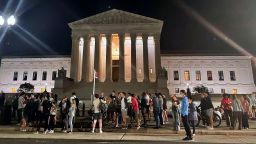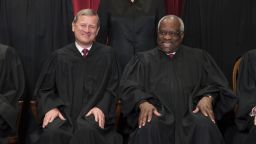Supreme Court justices take extraordinary precautions to protect their internal deliberations. They swear their law clerks to secrecy. They shred documents. They never reveal in advance when specific decisions will be announced.
Some justices even object when colleagues arrange for their private papers to be turned over to the Library of Congress decades later when they die.
But their quest for secrecy failed to prevent the public disclosure of a first-draft opinion, a stunning 98-page document in an abortion case for the ages.
After Politico on Monday published the draft opinion by Justice Samuel Alito that would bring the reversal of the 1973 Roe v. Wade landmark, Chief Justice John Roberts focused on “this betrayal of the confidences at the Court.”
He directed the court’s marshal, overseeing the building’s regular police force, “to launch an investigation into the source of the leak.” The chief justice said nothing about whether extra resources might be put toward the effort, whether outside experts might be enlisted and whether findings might become public.
Much is unspecified about the investigation, and it remains uncertain whether the source of the Politico disclosure will ever be known. But what is certain is the court’s extreme drive for secrecy, in all manner of operations, even those unrelated to deliberations on a case.
Irrespective of this breach, the justices’ general lack of transparency has increasingly become the subject of debate, including by President Joe Biden’s bipartisan commission on court reform.
Among the issues: that the justices often issue late-night orders with no recorded votes or explanation; that they keep secret certain procedural rules related to when cases are accepted for review; and that they lack a formal code of ethics and fail to explain recusals and potential conflicts of interest.
More from CNN
They prohibit cameras in the courtroom, and some justices go to great lengths to keep the news media from their off-bench speeches by limiting advance announcements, forbidding taping or outright barring journalists. They decline to disclose even basic information about their health and hospitalizations.
Yet the deliberative process regarding cases is a whole other matter. The court justifiably wants to ensure candid internal debate and allow for persuasive negotiation and changed views. Its ultimate decisions affect people beyond the dueling litigants, reaching the lives and liberties of others across the country and often moving financial markets.
In this instance, if the justices overturn nearly a half century of women’s abortion rights, they will upend constitutional privacy rights and scramble many Americans’ domestic choices and economic lives.
So the decision-making process remains intensely private. Per tradition, the nine meet alone in a small oak-paneled conference room off the chambers of the chief justice as they discuss and vote on a case. (A preliminary vote occurs a few days after oral arguments; votes can shift as opinions are drafted and circulated in the months following.)
After that initial session at what the justices call “the conference,” individual justices inform their law clerks about the outcome, and the clerks assist in the research and writing of opinions. Clerks – each justice employs four per annual session – closely track all developments in a case and the continuing private discussions among the justices.
When clerks are hired each summer, before the annual term begins in October, they take a vow of confidentiality. Through the years, chief justices have reminded the clerks of their pledge as the term nears its end in late June and public expectations rise.
Roberts usually decides which justice will write the court’s main opinion. If he himself is not in the majority on the case, the most senior justice in the majority assigns the leading court opinion. (The senior justice among the dissenters assigns the main opinion for that side, although justices are free to write additional dissenting or concurring statements.)
In the Mississippi abortion controversy, Justice Clarence Thomas was apparently the senior member of the five seeking to reverse Roe v. Wade. Thomas, then, would have assigned the opinion to Alito. Once any justice begins writing the opinion of the court, he or she tries to keep a majority, or, in the parlance of the court, “hold five.” The author fields requests for changes in language and rationale, trying to accommodate one colleague without alienating another and losing the majority.
Some justices have told CNN in the past that they did not minutely edit their colleagues; rather, they seek to make sure they agree with the bottom line and reasoning.
Alito’s February 10 draft, as published by Politico, has no doubt gone through multiple drafts by now, and other justices in the majority are likely writing separate concurring opinions, adding their particular views to a reproductive rights case of such magnitude. Multiple dissents may be in the works as well.
From legal pads to shreds
Some justices begin composing their opinions on legal pads; others go right to the computer. All draft opinions are printed out and circulated among the nine chambers by court aides. So there would be both electronic and paper copies of draft opinions throughout the justices’ chambers.
Documents to be discarded are shredded and burned.
Individual justices often retain opinion drafts and memorandums associated with cases. Early drafts, at least from past cases, can be found in justices’ archives at the Library of Congress and in certain law libraries.
Irrespective of what is saved, the court has extensive rules about materials that law clerks may remove from the building and the use of its dual computer systems. Former law clerks told CNN that court opinions are supposed to be handled only on the closed, internal computer system, not the one through which justices, law clerks and other employees communicate with outsiders.
RELATED: Private SCOTUS files that could reveal what happened in Bush v. Gore remain locked up
Sources tell CNN that court employees take care to lock their desks and shred sensitive materials. But justices sometimes travel with their work, and like all institutions that have rules for computer use and document protection, compliance depends on the people involved. Roberts declared in his Tuesday statement that the disclosure arose from “a singular and egregious breach of trust.”
“We at the Court are blessed to have a workforce – permanent employees and law clerks alike – intensely loyal to the institution and dedicated to the rule of law,” he said.
Roberts has tried to keep tight control of court operations. During oral arguments last December in the Mississippi abortion case, in fact, he expressed his disapproval of arrangements that past justices have made with the Library of Congress.
He referred to documents in the archive of the late Justice Harry Blackmun, the author of Roe, that became public more than three decades after the 1973 decision.
Roberts declared the documents “an unfortunate source” and said there was “good reason not to have papers out that early.”
With this week’s disclosure of a contemporaneous first draft, those decades-old archival materials became the least of the justices’ concerns.







